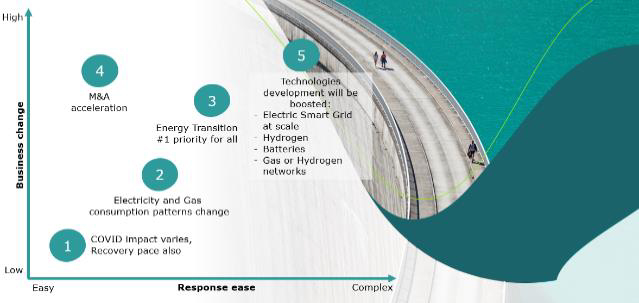Intelligent Automation As An Energetic Accelerator

Roel Hoeks, Co-Founder & Managing Partner at Roborana NL and EsperantoXL

Chris Vinke, Founder & CEO at GRN Consultancy BV
Over the last twelve months, the Energy and Utilities (EUC) industry as a whole has been characterized by two opposing narratives, juxtaposed against one another:
The first narrative is that we have to be moving towards more sustainable energy sources because of widespread climate change and The first narrative is that we have to be moving towards more sustainable energy sources because of widespread climate change and vast technological advancement which is making it possible. The Paris Agreement’s target in terms of acceptable global warming is around 1.5–2°C, a figure we are far away from at present. On the other side of the coin, the economic impacts of the COVID-19 pandemic has reset the baseline for the industry and a new normal has been established.
The transition to renewable energy is no longer the gamut of energy companies alone. Consumers of all kinds are looking to become independent of state-owned grids, so they can derive their energy sustainably, as well as considering alternative decentralized technologies that purport to minimize CO2 emissions directly. And beyond that, more and more companies across the globe are taking charge of their own energy transition and accelerating it wherever possible. These organizations are tired of waiting and are now taking things into their own hands. This trend will have a significant effect on the entire energy market and the role that each part of the value chain plays.
The Energy & Utilities of the Future
There has been widespread social pressure from a wide range of stakeholders who are starting to heed the call of climate scientists and push for change. This has only intensified over the past year thanks to a renewed focus on the tents of the Paris Climate Accord. Businesses of all types are starting to spend a lot of time and resources reporting to shareholders on their sustainability and CO2 emissions because it is such a hot button topic.
On the extreme end of this, a number of global entities have announced plans to fully decarbonize over the next three decades— which is bold, specially in the aftermath of this pandemic. In fact, as intermittent renewables recorded record-high saturation levels and the peak oil demand came into the zeitgeist, COVID-19 helped to crystallize just how urgent this transition needs to be and what it all entails. The broader energy industry is likely to start converging in the coming year, as many players seek to reposition themselves carefully in the wave towards mass electrification. Energy providers who were traditionally dependent on oil production are likely to start investing elsewhere across the value chain to diversify their operations. Automakers are going to continue shifting towards electric vehicles (EVs) in all their forms, which will naturally seed the demand and creation of more advanced grid infrastructure and battery storage development. With the infrastructure in place, it’s not out of the realm of possibility to suggest that they might even seek to become renewable and electric service providers themselves.
Technology companies may also make this shift, enabling vehicles, homes, and businesses to serve as distributed energy resources (DER) in addition to merely consuming energy. The convergence of the electric, transportation, and building sectors is likely to result in companies with varying levels of regulatory, technological, and capital constraints and opportunities partnering (or competing) with power and utility industry companies. All of these players are looking to establish a strategic foothold in a new energy landscape characterized by the five trends in the image below.

Trends in Energy & Utilities Global Challenges
The EUC sector faces a number of challenges to the traditional business model – which will force it to go through a full transformation overthe next few years. The global changes can be summarized in three main points:
1. A great energy disruption
Mainly due to the big data revolution combined with accelerated digital transformation that we are seeing all around the world. There are tremendous insights to be gleaned from working with big data and when you layer these data sources on top of one another, you can derive incredible value that drives strategic decision making. But even if you ignore that part, the pure digitalization play along the P&U value chain and exponentially improving technology is going to greatly improve efficiency across the board.
2. A cleaner energy mix
Under scrutiny from the European Union, the energy mix being produced by each member country will have to transform from grey energy (e.g., coal) to green energy (e.g., wind, hydro and solar). The regulatory pressure combined with social pressure should be enough to shift perceptions within these governments and start to catalyze radical shifts in policy and execution. Then on a community-based level, the last piece of this puzzle is the rise of mass-market electric vehicles. Initially, electric vehicles gained momentum on the back of state subsidies and a small contingent of eco-friendly consumers. But as the cost of storing energy continues to come down, the economic incentives are going to outweigh the environmental ones, shifting behavior, and buying patterns as it does so.
3. A complex business model
Arises because this low-carbon energy is not a straight swap for the old types. To create a low-carbon energy business that is sustainable, it comes with the development of some new products and services that make the whole thing work. As a result, in an attempt to encourage this holistic approach, it’s likely that regulations will decrease over time, lowering the barriers to entry and increasing competition. From a price point of view, the market will be characterized as highly volatile. As the world grasps for clean, safe, cheap, and reliable energy, the increased demand may fuel a backlash against traditional, centralized power sources. Reliance on renewable energy sources will continue to grow, and the sector will evolve from one that is highly regulated to one that is open for innovation because customers are going to transform from passive consumers to demanding prosumers. They will demand intelligent automation and augmented utilities that can meet the rigorous demands of the future.
Local Challenges
If we look a bit closer to home, the transition from conventional energy production to more sustainable sources is going to cause large variations in energy prices which will make it difficult for energy companies to cope. As the market conditions shift under their feet, they will be forced to adapt or die. In addition, we will see a number of new players enter the market to disrupt and deliver on the use cases of the future. A good example of this is electric transport, one of the key drivers of this entire movement. Sectors will converge in a way like we’ve never seen before. Initiatives like Campus@sea, where all those challenges are met with enthusiasm and ways to innovate https://www.campusatsea.nl/
Based on discussions with our customers, we’ve identified the following relevant themes/trends in the market:
- Increased e-Mobility
- Rollout of Smart & Micro Grids
- Corporate Power Purchase Agreements (PPAs)
- Expansion of renewable energy and storage
- Re-evaluation of conventional energy
- Decommissioning of offshore assets in NL
- Cost reduction and investments
- Investment in hydrogen
- Digital customer engagement
- Chemicals: Reducing CO2 and tran-sitioning to green chemistry
This is not an exclusive list, but it should give you a sense as to where we are headed.
Local ChallengesDigital Transformation in Utilities Intelligent Automation
One of the most exciting technologies to come from the last few years has been the rise of intelligent automation. By taking tasks and offloading them to smart algorithms, companies of all kinds are lowering their Total Cost of Ownership (TCO), improving their Return On Investment (ROI), and drastically simplifying how they run. As an example, the increasing demand for reduction of packaging, optimization of logistics, and pressure on food supply chains, combined with the current epidemic turning the tide to reduce costs and keep operational margins make intelligent automation a top priority (Forrester, 2020). Automation has enabled a vast expansion of remote work and it greatly improved processing requirements. 23% of survey respondents said they have prioritized automation that improves their organizational resilience (UiPath, 2021). Utilities are no exception. The energy providers that are going to thrive in this new world are going to be the ones that can leverage the power of intelligent automation to supercharge their operations in every facet. The more that can be done in this way, the better.
Bridging the Gap Between Business & IT
This is not something that can be ignored. Whether you like it or not, the stakeholders who don’t upskill themselves and therefore lack knowledge of these new options are going to find themselves being left out of these important initiatives. Reskilling plans and revised role definitions that are based on how the human workforce will interact with machines should be baked into intelligent automation adoption plans. This change management is as important as the technology itself.
Workers should reimagine how they work from first principles. While substituting intelligent machines for human workers may reduce costs in some cases, you leave a lot of value on the table if you stop there. Mere automation does not necessarily translate into value and new meaning. You have to go above and beyond to imagine how this technology can augment your operations.
To capture the significant productivity gains that are there for the taking, these technologies need to work harmoniously together in order to deliver new work outcomes. Business leaders must push outside the boundaries of old process maps, looking beyond the limitations of currently used technology, and using automation to fundamentally transform the way that work gets done (Deloitte, 2020). This is especially true for utilities who have done things the same way for so long now. Fresh thinking is required, taking into account what technology we now have at our disposal.
RPA: Remember that RPA is still a crucial part of Intelligent Automation
Robotic process automation (RPA), process analysis, process modelling, process improvement, and even business process management tools (BPM) have earned their rightful place as a key component of any automation execution roadmap. However, the automation of mundane tasks alone will not be enough (HFS, 2019). Again, you must go deeper than that.
As we sit here in 2022, it seems selfevident that using RPA as a kickstart for your automation journey is a good way to go (McKinsey, 2020). However, it’s just a step along the journey. You must go further to get the outcome that you desire, pulling together semi and structured data in an efficient manner. RPA bots are essential for taking over transactional activities of various types. For example, offloading data entry or copying data across systems allows your employees to free up time and resources to focus on more strategic tasks.
RPA provides the transition from servicesthrough-labor to services-through-software. It’s clear that RPA represents a significant lever that you can pull to significantly improve efficiency, robustness, and product quality alike. It’s especially valuable when dealing with repetitive processes, high transaction volumes, and cost critical processes.
- Providing managed services and transitioning to green chemistry
- Optimizing assets to reduce emissions and consumption
- Leveraging data and providing insights to dive sustainable performance
Combining orchestration with RPA in this way creates flexible, long-lasting solutions and bots that can self-manage exceptions. This makes the whole system that much more robust. To even get more insights and validate the business value of the Intelligent automation project, process mining could be leveraged where applicable.
Roborana’s different solutions
Our tool-agnostic approach provides a rich set of application development tools and best practices designed to capture business requirements, build business logic, and transform how the operations have been done for years at lower risk and costs. We are passionate about bringing this power to clients and fitting seamlessly into their existing workflows. Create bots in minutes instead of months or years by working with a professional firm that has the experience and expertise that you can leverage. We’ve seen the good, the bad, and the ugly – you don’t have to make those same mistakes. Let’s talk.
Roborana NL is a Robotic Competence Center, part of Cronos Group and EsperantoXL. We help organizations to embed virtual workers and to automate repetitive processes.
Vision of GRN
In 3 years we want to have done our part for the 2050 goal of feeding the world with digital solutions, robotization, automation and AI & IoT. By helping to reduce waste, increase efficiency and embrace the transition of a circular world. Starting small, our 90-day plan is the first step in the right direction. What we need is support from our potential partners to make the journey and make them more digital with our Intelligent Automation, conceptualization and training.